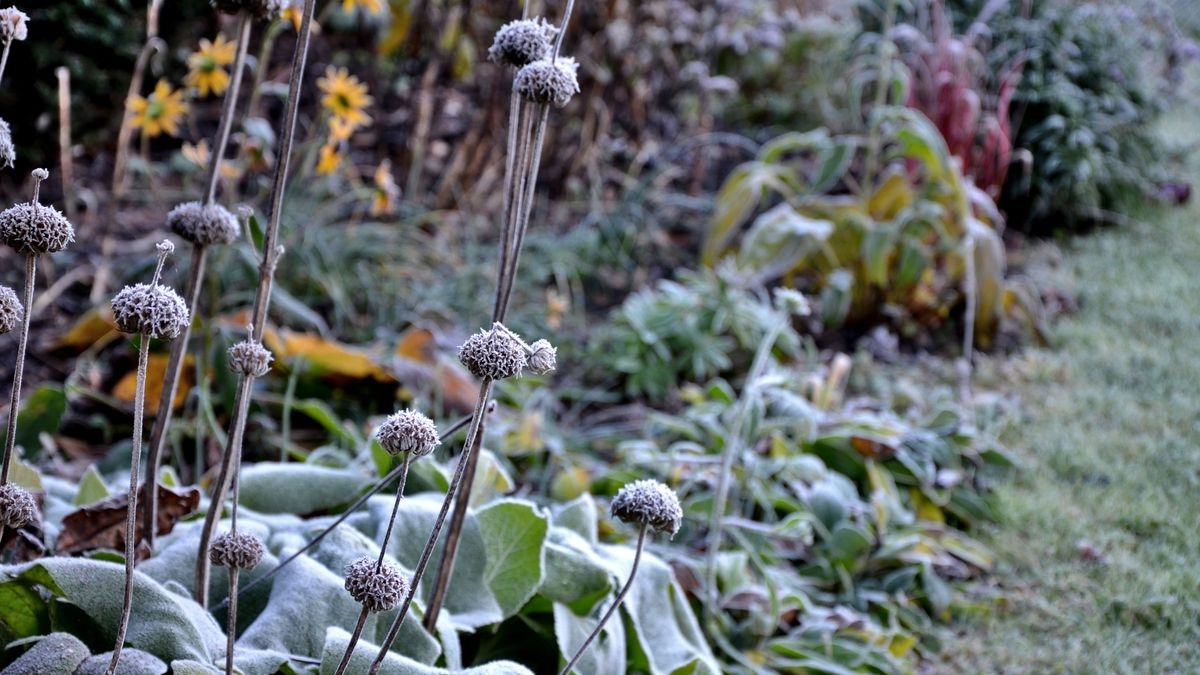Home>Weather and Climate>Protect Your Plants: Tips For Dealing With A Freeze Warning


Weather and Climate
Protect Your Plants: Tips For Dealing With A Freeze Warning
Published: March 4, 2024
Learn how to protect your plants from freezing temperatures with our expert tips. Get prepared for a freeze warning with our weather and climate advice. Protect your garden today!
(Many of the links in this article redirect to a specific reviewed product. Your purchase of these products through affiliate links helps to generate commission for Temperatures.com, at no extra cost. Learn more)
Table of Contents
Understanding Freeze Warnings
Freeze warnings are crucial alerts issued by meteorological agencies to notify the public about impending freezing temperatures. These warnings are typically issued when temperatures are expected to drop to 32°F (0°C) or below, posing a significant risk to plants, crops, and outdoor plumbing. Understanding freeze warnings is essential for protecting your garden and landscape from potential damage.
When a freeze warning is announced, it indicates that the weather conditions are favorable for freezing temperatures within the next 24 to 36 hours. This advanced notice allows gardeners and homeowners to take proactive measures to safeguard their plants and outdoor infrastructure from the potential harm caused by freezing temperatures.
It's important to note that freeze warnings can vary in severity, ranging from a light frost to a hard freeze. A light frost occurs when temperatures briefly dip below freezing, causing minimal damage to hardy plants. On the other hand, a hard freeze occurs when temperatures remain below freezing for an extended period, leading to more severe damage to a wider range of plants.
In regions where freezing temperatures are less common, the issuance of a freeze warning can prompt significant concern and action. However, in areas accustomed to cold weather, residents may be more familiar with the necessary precautions to protect their plants and property.
Understanding the nuances of freeze warnings, including the difference between a frost advisory and a freeze warning, can help individuals make informed decisions about how to prepare for the impending cold snap. A frost advisory typically indicates the likelihood of lighter, less damaging freezing temperatures, while a freeze warning signals the potential for more severe and prolonged freezing conditions.
By staying informed about freeze warnings and their implications, individuals can effectively plan and implement strategies to mitigate the potential damage caused by freezing temperatures. This proactive approach can help minimize the impact of freezing conditions on plants, gardens, and outdoor infrastructure, ultimately preserving the beauty and vitality of outdoor spaces.
Preparing Your Plants for a Freeze
When a freeze warning is issued, it's essential to take proactive steps to protect your plants from the potential harm caused by freezing temperatures. By preparing your plants for a freeze, you can minimize the risk of damage and help them withstand the cold conditions more effectively.
Assess Your Garden
Before the freeze sets in, take a thorough inventory of your garden and identify the plants that are most vulnerable to freezing temperatures. Tender annuals, tropical plants, and young seedlings are particularly susceptible to cold weather and require special attention. Additionally, consider the microclimates within your garden, as certain areas may be more sheltered or prone to frost accumulation.
Watering
Proper hydration is crucial for plant resilience during a freeze. Ensure that your plants are adequately watered before the onset of freezing temperatures. Well-hydrated plants are better equipped to endure the cold, as moisture within the plant tissues can act as a protective barrier against frost damage. However, it's important to avoid overwatering, as waterlogged soil can exacerbate the impact of freezing temperatures on plant roots.
Mulching
Apply a layer of organic mulch around the base of vulnerable plants to provide insulation and retain soil warmth. Mulch helps regulate soil temperature and minimizes temperature fluctuations, offering a protective buffer for plant roots. Additionally, mulch can reduce moisture loss from the soil, helping to maintain a more stable and hospitable environment for plant roots during freezing conditions.
Read more: Tips For Caring For Your Meyer Lemon Tree
Covering Plants
For individual plants or small garden beds, consider using protective coverings such as frost cloths, blankets, or burlap to shield vulnerable vegetation from the cold. These coverings can trap heat radiating from the soil and create a microclimate around the plants, offering a degree of protection against freezing temperatures. Be sure to secure the coverings firmly to prevent them from being dislodged by wind or inclement weather.
Bring Potted Plants Indoors
If you have potted plants that are sensitive to freezing temperatures, relocate them to a sheltered area, such as a garage, shed, or enclosed porch. Indoor relocation provides a controlled environment that shields potted plants from the harsh effects of freezing temperatures, safeguarding them until the weather becomes more favorable.
Pruning and Harvesting
Before the freeze, consider pruning any damaged or diseased foliage from your plants. Additionally, harvest any remaining fruits or vegetables that are at risk of being damaged by the cold. By removing vulnerable plant parts and harvesting produce, you can redirect the plant's energy towards healthier growth and protect valuable crops from frost damage.
By implementing these proactive measures and preparing your plants for a freeze, you can significantly reduce the risk of cold-related damage and help your garden thrive despite the challenging weather conditions. Taking the time to safeguard your plants demonstrates a commitment to nurturing a vibrant and resilient outdoor space, ensuring that your garden remains a source of beauty and enjoyment throughout the changing seasons.
Protecting Sensitive Plants
Protecting sensitive plants from freezing temperatures requires strategic measures to shield them from the potential harm caused by cold weather. These vulnerable plants, including tender annuals, tropical species, and young seedlings, are particularly susceptible to frost damage and necessitate special attention during freeze warnings. By implementing targeted protective strategies, gardeners can help these delicate plants withstand the cold and emerge unscathed from the freezing conditions.
Selective Covering
When facing an impending freeze, selective covering can be a valuable technique for safeguarding sensitive plants. Utilizing frost cloths, blankets, or burlap, carefully drape these protective coverings over the vulnerable vegetation, creating a shield against the chilling effects of freezing temperatures. The coverings act as insulating barriers, trapping heat radiating from the soil and forming a microclimate around the plants. This microclimate helps maintain a more temperate environment, shielding the sensitive plants from the harsh impact of the cold.
Enclosure and Shelter
In situations where potted plants or container gardens are at risk, providing them with temporary enclosure and shelter can offer vital protection. Relocating these vulnerable plants to a sheltered area, such as a garage, shed, or enclosed porch, shields them from the direct effects of freezing temperatures. This controlled environment provides a refuge from the cold, preserving the delicate plants until the weather becomes more favorable. Additionally, grouping potted plants together can create a collective warmth that further enhances their resilience against the cold.
Mulching and Insulation
Applying a layer of organic mulch around the base of sensitive plants serves as an effective form of insulation, safeguarding them from the harsh impact of freezing temperatures. Mulch acts as a protective barrier, regulating soil temperature and minimizing temperature fluctuations that can harm delicate plant roots. This insulation helps maintain a stable and hospitable environment for the plants, reducing the risk of frost damage and promoting their ability to withstand the cold with greater resilience.
Watering and Hydration
Ensuring that sensitive plants are adequately hydrated before the onset of freezing temperatures is crucial for their ability to endure the cold. Proper hydration helps fortify the plants against frost damage, as moisture within the plant tissues acts as a protective barrier. However, it is important to strike a balance and avoid overwatering, as waterlogged soil can exacerbate the impact of freezing temperatures on plant roots. By maintaining optimal hydration levels, gardeners can bolster the resilience of sensitive plants and enhance their ability to withstand the challenges posed by freezing conditions.
Protective Strategies
Implementing these protective strategies can significantly reduce the vulnerability of sensitive plants to freezing temperatures, allowing them to thrive despite the challenging weather conditions. By prioritizing the protection of these delicate plants, gardeners demonstrate a commitment to nurturing a vibrant and resilient outdoor space, ensuring that their garden remains a source of beauty and enjoyment throughout the changing seasons.
Dealing with Frost Damage
Dealing with the aftermath of frost damage in the garden can be disheartening, but it's essential to take prompt and effective measures to support the recovery of affected plants. When frost strikes, it can cause visible harm to foliage, stems, and flowers, impacting the overall health and vitality of the garden. However, with proactive intervention and attentive care, it is possible to mitigate the effects of frost damage and encourage the rejuvenation of affected vegetation.
Upon discovering frost-damaged plants, it's crucial to resist the urge to immediately prune away the damaged portions. While the frost-damaged foliage may appear unsightly, it can provide a protective layer for the underlying plant tissues. Prematurely removing the damaged foliage can expose the plant to further harm if subsequent frost events occur. Instead, it's advisable to wait until the threat of frost has passed before assessing the extent of the damage and initiating targeted pruning.
As the threat of frost subsides, carefully inspect the affected plants to evaluate the severity of the damage. Look for signs of wilting, browning, or discoloration in the foliage and stems. In some cases, the damage may be superficial, primarily affecting the outer layers of the plant, while the underlying tissues remain viable. However, if the damage is extensive and widespread, it may indicate more significant harm to the plant's overall health.
When determining the appropriate course of action, it's important to prioritize the preservation of healthy plant tissues and the promotion of new growth. Begin by gently removing the frost-damaged foliage and stems, making clean cuts to minimize stress on the plant. Focus on removing the visibly damaged portions while preserving the healthy growth, allowing the plant to redirect its resources towards recovery and regeneration.
Following the initial pruning, provide the affected plants with optimal care to support their recuperation. Ensure that the plants receive adequate water and nutrients to bolster their resilience and encourage new growth. Consider applying a balanced fertilizer to replenish essential nutrients and promote the development of healthy foliage. Additionally, monitor the plants closely for signs of regrowth, as this indicates their capacity to rebound from the frost damage.
In some cases, providing temporary shade or shelter for the affected plants can offer protection from direct sunlight and environmental stress, facilitating their recovery process. This can be particularly beneficial for plants that have experienced severe frost damage and require additional support as they undergo the rejuvenation process.
By implementing these targeted strategies and providing attentive care, gardeners can effectively address the impact of frost damage and foster the revitalization of affected plants. While the visible effects of frost damage may initially seem discouraging, proactive intervention and nurturing care can contribute to the successful recovery of the garden, allowing it to flourish once again in the wake of challenging weather conditions.
Recovering Your Garden After a Freeze
Recovering your garden after a freeze is a pivotal phase that demands deliberate and attentive efforts to restore the health and vitality of your outdoor space. Following a freeze event, the garden may exhibit visible signs of damage, including wilted foliage, browning stems, and overall distress among the plants. However, with strategic intervention and nurturing care, it is possible to facilitate the recovery of the garden and encourage the resurgence of its natural beauty.
Upon the subsiding of freezing temperatures, it is essential to conduct a comprehensive assessment of the garden to evaluate the extent of the damage. Take the time to inspect each plant, observing the condition of the foliage, stems, and overall growth. While some plants may have incurred minimal harm, others may exhibit more pronounced signs of frost damage, necessitating targeted attention and support.
As you embark on the journey of garden recovery, prioritize the removal of any visibly damaged or wilted foliage. Pruning the affected plants with precision and care can promote new growth and redirect the plant's resources towards rejuvenation. By selectively removing the damaged portions while preserving the healthy growth, you create an environment conducive to the plants' recovery and regrowth.
In addition to pruning, it is crucial to provide the garden with optimal care and nourishment to support its recuperation. Ensure that the plants receive adequate water, as consistent hydration is essential for their resilience and regrowth. Consider supplementing their nutrition with a balanced fertilizer to replenish vital nutrients and stimulate healthy foliage development. By attending to the plants' essential needs, you create a nurturing environment that fosters their recovery and revitalization.
Furthermore, monitoring the garden closely for signs of regrowth and new shoots is integral to gauging the progress of its recovery. The emergence of fresh foliage and the gradual return of vibrant colors signify the garden's resilience and its capacity to rebound from the challenges posed by the freeze. Celebrate these signs of renewal as they manifest, acknowledging the garden's inherent ability to overcome adversity and thrive once again.
As the garden undergoes the process of recovery, providing it with temporary shade or shelter can offer protection from environmental stress and promote its healing. This additional support can be particularly beneficial for plants that have experienced more severe frost damage, aiding them as they embark on the journey of rejuvenation.
By embracing the task of recovering your garden after a freeze with patience and dedication, you contribute to the restoration of its natural splendor and vitality. Through deliberate intervention, nurturing care, and a steadfast commitment to the garden's well-being, you play a pivotal role in guiding its resurgence and witnessing the triumphant return of its beauty and vibrancy.












